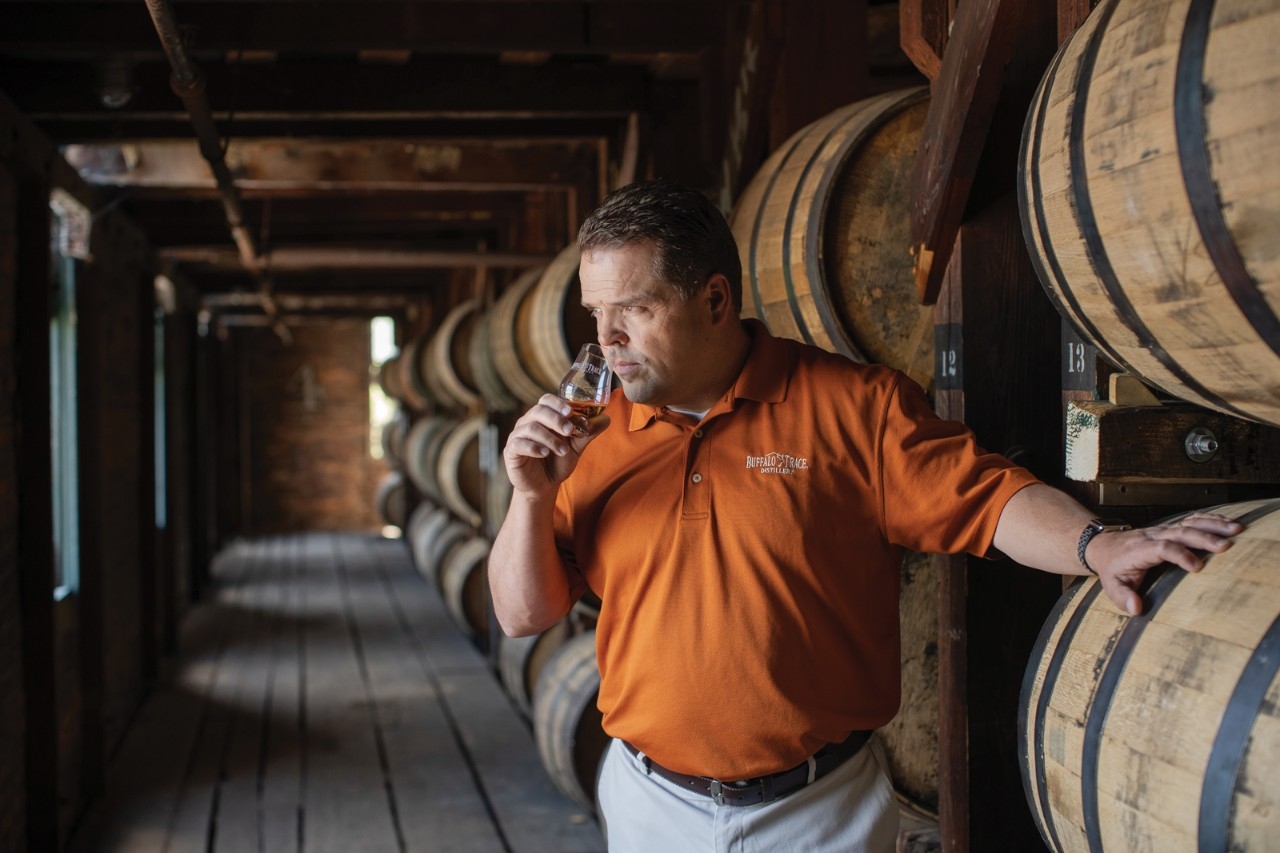


It’s true that Harlen Wheatley (’94) gets paid to taste bourbon, and, yes, he knows he has one of the best jobs in the world. But it’s not day drinking that puts a smile on the face of Buffalo Trace’s master distiller—he’s just really into chemistry.
“Nowadays, when people think about Buffalo Trace, they think about those whiskies in the bottle,” he says. “But when I started here, it was about the production facility.”
Wheatley’s role takes him both into the still house and around the globe for bourbon education, and his hard work hasn’t gone unnoticed—he’s been nominated for the James Beard Award four times, and Buffalo Trace’s whiskies are considered among the best spirits in the world by chefs and connoisseurs. But ask Wheatley about the man behind the brand, and his thoughts wander back to a boyhood in Union, Kentucky.
“It was pretty rural back then, and we did a lot of country things—you know, hunting and fishing,” he says, remembering a crossbow he built in shop class at Ockerman Middle School. “I’m assuming these days they’d never let you build that in school, but, yeah, it was a working crossbow. I put a spool on the front, shot fish and reeled them in. It was fun.”
In high school, he played soccer, baseball and, most notably, football—Wheatley was a linebacker for Boone County the year the team made it to the state title game—and excelled in every academic subject except one. “Chemistry was the class I had the most difficulty with in high school,” he says with a laugh. “I said, ‘I’m not going to let that stop me—that’s B.S. I’m going to figure it out.’”
This resolution brought him to Northern Kentucky University, where he enrolled in the university’s pre-engineering program, which, through an arrangement between the department of Physics and Geology and the University of Kentucky, allowed him to attend both NKU and UK for dual degrees in chemistry and chemical engineering. Wheatley faced the daunting challenge head on,starting college-level chemistry classes at NKU.
“It was tough,” says Wheatley. “I remember physical chemistry in particular; there were four people in the whole class. We had 12-hour exams, and there were maybe 20 8.5x11 sheets of paper. No lunch breaks, you’d just take in a pack of crackers. And the final was so long that we had to go to the professor’s basement to finish it. It was like 14 hours long.’” The professor, beloved chemist Vern Hicks, still holds a special place in Wheatley’s heart. “He was my favorite. I liked him a lot. He was a great teacher.” (The NKU Chemistry & Biochemistry department recently returned the love, awarding Wheatley with its 2019 Outstanding Alumni Award.)
Wheatley’s hard work paid off when, in 1994, a human resources representative from what was then the George T. Stagg Distillery in Frankfort contacted UK with a specific ask: Gary Gayheart, then-master distiller, was thinking about retirement and wanted an apprentice. Wheatley, recently graduated and working for a water treatment company, was named as a standout student, but he was hesitant to leave the job that got him through college. “I said, well, I’m not really looking for a job, but I’ll come check it out.”
The distillery won him over when he saw how much chemistry would be involved. “I was just wanting to apply stuff I knew,” he says. “It was about the production and all the things that go into that. It wasn’t about the bourbon so much at the time—that takes care of itself.”
He started as a supervisor in January 1995 and worked under Gayheart for 10 years until, in 2005, Wheatley was named master distiller, making him both the public face of Buffalo Trace and, as head of production, protector of the distillery’s 227-year-old legacy. “Anybody that grows up in Kentucky appreciates history, I think,” he says. “That’s definitely what enticed me to do a good job. I mean, we have hundreds of years of families and people that have worked here. If you screw it up, you’re kind of disgracing everybody behind you.”
The stakes were high, but Wheatley say she felt ready for the responsibility—he’d been trained well by Gayheart and maintained a passion for learning. “When I started, we had a whole lot of guys who had been here 30, 40 years. My theory was, these guys have seen and done it, so I'd better try to absorb all I could,” he says. “I think it’s really important to build a foundation of institutional knowledge, and I think it’s that way with any job. You don’t know it all, I don’t care what job you’re in, and you have to learn from others around you.”
Wheatley now travels the world talking about Kentucky straight bourbon whiskey (“All those words mean something on thatbottle,” he says) and hosting events—critical elements of his job, given bourbon’s recent surge in popularity. But on days when he’s at home, in the historic distillery on the banks of the Kentucky River, he’s back at chemistry, overseeing production to maintain consistency of Buffalo Trace’s whiskies and experimenting with new techniques and ingredients in pursuit of what he calls the “Holy Grail”—a perfect bourbon.
“You definitely use your laboratory and chemistry background to think of the endless options that are there,” he says. “But consistency is the key to producing a good bourbon. When you break it down on the production side, there are probably 100 different processes, and you have to do each one of them consistently to produce that consistent product.
”But about those tastings? They're important, of course, to ensure Buffalo Trace whiskies are what their customers deserve—the best. “It’s all about producing authentic products that people will go out and search for, and be confident when they buy it,” hesays. “It’s our formula. It’s really a simple thing for us, but it’s really important.”
